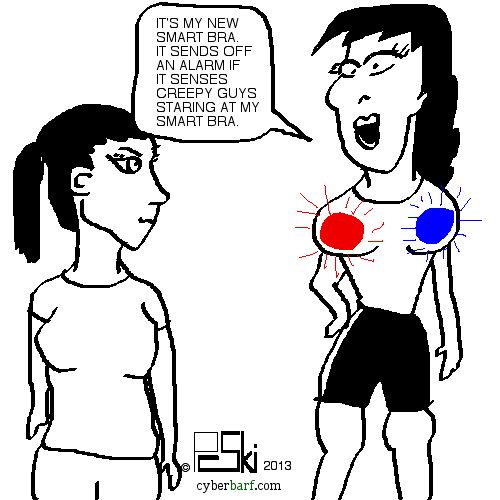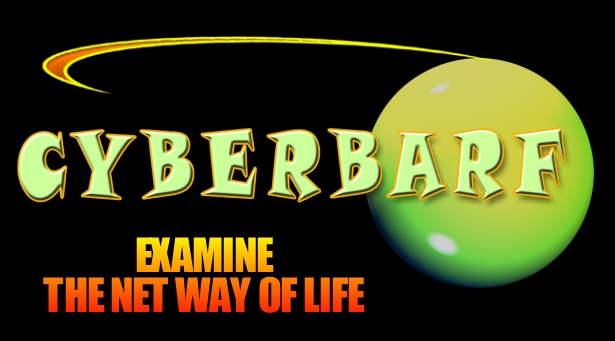|
cyberbarf VOLUME 13 NO. 6 EXAMINE THE NET WAY OF LIFE JANUARY, 2014 IN THIS ISSUE:
DRONE ON BARFETTES MAX SECURITY SYSTEMS SMART BRA, BRO! iTOONS WHETHER REPORT NEW REAL NEWS KOMIX! SHOW HACK!
|
|
cyberbarf EXAMINE THE NET WAY OF LIFE
START THE HOLIDAY SHOPPING SEASON WITH
CYBERBARF T-SHIRTS, MUGS & MORE
THANK YOU FOR YOUR SUPPORT!
CYBERBARF
THANK YOUR FOR YOUR CONTINUED SUPPORT.
|
|
cyberbarf EXAMINE THE NET WAY OF LIFE cyberbarf DRONE ON TECHNOLOGY Amazon wants to convert military drone technology into a high tech delivery service. Good luck with that. This idea has landed on most worst idea Top Ten lists of 2013. Most people probably do not realize that Amazon is a highly automated company. When one orders on-line, the product requests are sent electronically to a fulfillment center where robots drop bar coded boxes into a shipping container that zips along a conveyor belt toward the shipping department. Robots and data base matching is fine for computerized devices to find and drop a DVD into a cardboard box. But it takes more interactive skill sets to get that sealed box to someone's door step. The reason why Amazon wants to automate more, is that is a company with very low profit margins. Human beings as workers are costly work machines. A large part of overhead costs are salaries and benefits. So, if one can remove the human element to any repetitive task, in management schools, that should equate to higher profits. But Amazon like most retailers have outsourced the actual delivery process to FedEx or UPS, who have to burden the associated costs of handlers, sorters and delivery drivers. So why would Amazon want to carpet bomb America with packages from the skies? There is a cool factor. For every Google Glass, there are hundreds of bar napkins with other crazy ideas. For example, for more than 40 years, people have dreamed of having Star Trek food replicators in their homes. Now, with the advent of expanded uses of 3D printers, there are a few courageous souls who want to replace plastic molding materials with actual food ingredients to build (fresh) vending machine pizzas. It was an off-shoot of the ink jet printers, but replacing the ink cartridges with cheese and tomato sauce seemed outrageously complex. It probably costs less than a dollar to make a large pizza from scratch with water, flour. salt, tomato paste and shredded cheese. But technology now is not about making things - - - it about making things that will make other things. The other issue with the Amazon drone story is that it makes little financial sense. If one thinks that the drones will fly themselves to parts all across the country, that is foolish. Drone technology comes from military defense contractors. The basic drone used in the Middle East is a rocket-glider that carries a attack missile. It is controlled remotely by a highly specialized drone pilot. The same human interaction would be required to drop a package on your doorstep as it is to launch a rocket into a terrorist cell. Skilled drone pilots would probably cost more money than handing off a package to a delivery driver. Besides, GPS mapping and location systems are not perfect. From the air, a drone is not going to be able to see house numbers or read apartment units inside a lobby of a building. And how are the drones supposed to get a signature for the package? Drop a pen and clipboard from a rope as it hovers above the roofline? In addition, how are the drones going to get from a warehouse in Kansas to suburban Chicago? The FAA has enough on its plate keeping the thousands of commercial and private aircraft in the skies without banging into each other. Add thousands of low flying drones around metro areas, including busy airports, it is the recipe for a disaster movie. But the FAA recently announced commercial drone studies in six areas across the country to determine the feasibility and requirements for drone traffic. It is speculated that most initial drone traffic would be local law enforcement agencies. It is a grand plan, but not well thought out. But it did get Jeff Bezos and his company millions in free advertising just before the holiday season. A holiday season which had major shipping issues due to a surge of last minute buying (and expedited delivery promises) that Amazon, UPS and FedEx could not keep.
cyberbarf barfette The Xbox One is a pretty neat machine. It's graphics engine is smooth and game play fast (at least off-line). The new controllers are smaller with vibration feed back for certain games like Forza 5 auto racing. The screen imagines are high quality with no pixelation or screen shutter. Microsoft is trying to use this device as its home entertainment/internet hub. It may succeed with its concept if it can integrate those functions as smoothly as it did with the game engine. barfette After beating down Apple for a year about being a boring money machine, Wall Street analysts woke up to pretty up their mock portfolios by buying up Apple stock to near a 52 week high. The push was made by the announcement that Apple has inked a deal with China Mobile, China's largest cell phone carrier, to offer iPhones to its massive 743 million consumer base. Even if the iPhone sells 12 percent to China Mobile customers, it is estimated that alone would kick in at least another $18 billion in profits for Apple. barfette The ease of adoption of technology with children is accelerating to the point of awe. A two year old can ask for a parent's iPhone, turn it on, then scroll through the camera roll to show their uncle and cousins their vacation pictures at Disney World. They also can point, scroll, re-size, open and play games on their own iPads, which is now a more preferred device even for little kids because the screen is so much bigger. The cry that there is a saturation point for electronic device sales has been put off for at least a couple more years until these tikes get into elementary school, where they'd want the newest laptop to do their homework on.
cyberbarf EXAMINE THE NET WAY OF LIFE cyberbarf MAX SECURITY SYSTEMS CYBERSAFARI I have always said that my Doctoral Thesis would have been on the subject that everything shown in the 1980s television science fiction series Max Headroom has come true. Will we never learn from past television shows? The premise of the show was that the world has gone totally global, interconnected by the Web that creates a dark future of an elite, technology class and a fringe society on the outskirts of the metro areas. The televisions networks live and die by real time ratings. Every person's life has been digitized, including the show main protagonist, video news reporter Edison Carter, who after having an accident has his brain downloaded into Network 23's mainframe to create a new program, called Max, who has the same memories and personalities of his human blueprint. The show aired in the 1980s, when a new movement of writers wary of technology and the future arrived on the scene. These cyberpunks adopted a taunt, intense, and pulpy writing style, based on brisk yet detailed representations of a near future populated by multi-national corporations, colorful youth gangs, and computer hacker protagonists. Their most important theme was the total fusion of human and machine intelligences. Writers developed a shared set of themes and images, which were freely adopted by Max Headroom, which depicted a society of harsh class inequalities where predators roam the street looking for unsuspecting citizens in a world ruled by powerful corporations locked in a ruthless competition for consumer dollars and television rating points. Because everything in everyone's life has been digitized in massive databanks of information, a real commodity to be bought and sold, a subversive underground of have-nots develops to try to keep basic aspects of human liberty and freedom alive in a society imposing more control on everything. Max Headroom was a show way ahead of its time in its vision of the future and story ideas. But by today's standards, it could be considered chillingly psychic. In Episode 6, Security Systems Security Systems Inc. is the largest security firm in the world, with connections to the government, corporations, and the police. Somebody is trying to take it over, and Carter wants to know who. But SSI has an artificial intelligence of its own with one or two ideas about what to do with nosy reporters. This episode showcases the corruption inherit in one agency, whether be private or government, controlling all the information about any individual. It is just not the safekeeping of the information such as bank accounts, health records, criminal files but the manipulation of these databases to harm opponents or destroy competitors. Even today, if a credit reporting company inadvertently puts in error in an individual data base files, it could destroy that person's credit rating. But think about the abuse of power if a person can intentionally manipulate the data files to really destroy a person, publicly, financially and even criminally. This is why civil libertarians are up in arms over the National Security Agency's (NSA) megadata collection and domestic spying programs. The first part of the scandal is the constitutional privacy issue. The government cannot seize information on private citizens without an express and specific warrant from a court of law. The second part of the scandal is even worse: time and time again NSA and administration officials have publicly lied about the nature and extent of the programs. And when they get caught, they tell more lies until those lies are exposed by the media. It is no wonder that the cesspool of Washington D.C. public officials has so many private citizens fuming over out-of-control programs and mandates. A recent Gallup poll shows that an astonishing 80 percent of the American population does not trust the government. 80 percent! But now the agencies of that distrusted institution have primary access over every individual's personal information. And it is not just telephone records, web browser histories - - - with other programs such as Obamacare, the government will be demanding and taking full copies of all your health care, financial, earnings, investments, bank account transactions. Why? Because they can continue to amass these massive information data bases until someone stops them. Private industry has been data mining its customers for decades. Cookies in your web browser, to spam emails from affiliated services of your bank, consumers are aware of many of these collection techniques. The seriousness of the issue comes to the forefront when a department store or credit card processor is hacked and its data bases, which includes personal information and account access, falls in the hands of identify thieves. Civil libertarians see no difference between hackers and the NSA's sweeping data collection. And look who is in charge of all this personal information. The U.S. President is caught making a “selfie” at Nelson Mandela's funeral. The Director of the NSA admits he would not tell the truth to Congressional inquiries because it was not in his agency's best interest. Is there an adult in charge? There is no oversight outrage or internal accountability. One federal judge has ruled that the NSA's sweeping program as violating both the privacy of the First Amendment and unreasonable searches and seizures under the Fourth Amendment. But another federal judge ruled that the NSA program is legal because the information gathering is important as a “counterpunch” to 9-11. However, the NSA has not released one example that the spying on America has stopped any terror actions. The one example given to Congress was immediately disputed by NYC police, who said it was normal police investigation techniques that stopped a potential terror act. Some experts claim that the collection of data is so massive that it impossible for the NSA or government to actually use it. The idea of having all telephone and Internet metadata points as a method of connecting foreign terror dots is impossible. But in order to connect dots, you need to have a starting point, a suspect to track. If you have a suspect to track, then normal law enforcement can get a warrant to wire tap that suspect's telephone lines. But the counter-argument is that the NSA is not looking at the actual data, but trying to digest emerging “trends” such as increased chatter or communication to suspicious overseas areas. It is Orwellian for the government to have unchecked power over the lives and personal information of their citizens. The government is supposed to work on behalf of the citizens, not the other way around. Under the guise of security, government continues to erode personal liberties. This pattern has been repeated many times throughout history. It was more than 25 years ago, American television predicted that the concentration of personal data files can lead to abuse and corruption of that data. The final two years of the Obama administration will tell whether the pendulum of big government intrusion is going to break or whether it will swing back toward the original founding father's principles of individual rights and liberties.
cyberbarf SMART BRA, BRO! WEARTECH Microsoft is attempting to get in the smartwear apparel field. People have spent decades trying to incorporate computer technology into clothing. It rarely works. It rarely makes sense. Nike put a sensor in its running shoes to tie to app so athletes and work-out fiends could track their stat process during exercise. But Microsoft wants to put technology front and center . . . . chest high . . . . on the ladies. It is called the Smart Bra. It is going to be marketed toward young, active women who want to collect data such as cardio, pulse, workout stats, etc. It is not the first time that someone has tried to integrate technology directly into the fibers of clothing. The idea has been around for decades, but no one has gotten it to really work. One can weave in fiber optics and sensors into clothing to measure anything a measuring device could do. But the first obstacle is what do people really need or want their clothes to record for them? And the second obstacle has been what happens to all the electronics when you have to wash or clean the garment? Water and electronics do not mix. There are probably a few industries that could adapt sensor-wear into their daily routines. For example, hospitals could put in EKG monitors directly into hospital gowns to measure vitals such as pulse and temperature of a patient. That information could be sent directly by wi-fi to the nursing station. Dangerous occupations like miners could wear gear that would signal if there are high levels of toxic gas in their work areas. The closest thing to having any traction is the tacky light-up Christmas sweaters. Lights are sown onto sweaters to make blinking X-Mas light patterns to follow the winter scene crafted in wool. It is the least intrusive form of electronic wear. A once a year and battery operated piece of Griswold fun. There is another company who got around some of the wash and tear issues by putting a smartphone pouch on the front of a fleece jacket. One can slip the device into the chest pocket, and then the device can play music, videos or record what is going on in front of you. Again, the desired uses for such a hands free smartphone are not very clear. But again, it is better solution than sitting down on your smartphone and butt-calling random numbers. One application which has not been developed yet, and be our guest, is a jersey which has built in LED patches so, say, a sports team can have changing advertisements on their jerseys during a game, such as long soccer match. Television and advertisers have been pushing to get more ads into sports contests besides during the normal game breaks and time outs. Having LED patches on sports jerseys would solve that problem. But how would those electronic patches stand up to the rugged play of tackles, slides or even athletic sweat? Probably not too well. A sponsor would not want a patch malfunction in promoting its brand, say a soda from DRINK to a damaged patch saying STINK. Does someone working out on an exercise treadmill need to have their tweeter account scroll along their shirt sleeve? Or have their shoes blink or chime when they get a new facebook notification? Clothing that reacts to body temperature, moisture content, breathing rates . . . is it the new mood ring for the 21st Century? The idea that technology should be seamless on a person 24/7 is a noble, but misguided goal. |
|
THE PINDERMEDIA STORE IS FULL OF FUN T-SHIRTS CLOTHES, HATS AND OTHER ITEMS. CHECK OUT THE STORE FOR ITEMS
SUPPORT cyberbarf VISIT THE CYBERBARF STORE! Prices may vary depending on sales, allotments, inventory. |
|
cyberbarf.com EXAMINE THE NET WAY OF LIFE iToons
|
|
cyberbarf THE WHETHER REPORT |
cyberbarf STATUS |
| Question: Whether hard core gamers will rebel against on-line cloud licensed copies of games that they cannot resell after use? |
* Educated Guess * Possible * Probable * Beyond a Reasonable Doubt * Doubtful * Vapor Dream |
| Question: Whether Google and its Android OS will get caught up in global patent battles that will continue through the end of this decade? |
* Educated Guess * Possible * Probable * Beyond a Reasonable Doubt * Doubtful * Vapor Dream |
| Question: Whether the NFL's new Pro Bowl format of two team captains picking squads from a pool of players is to garner interest from fantasy football fans? |
* Educated Guess * Possible * Probable * Beyond a Reasonable Doubt * Doubtful * Vapor Dream |
|
cyberbarf EXAMINE THE NET WAY OF LIFE |
Writing is: the science of the various blisses of language. - - -Roland Barthes |
|
BACK IN BLACK WITH THIS CLASSIC CYBERBARF T-SHIRT!
FEATURING: THE REAL NEWS IMPACT EDITORIAL CARTOONS WRIGLEYVILLE WAR POLITICS ENDORPHIN RUSH THE DARK ABYSS RANDOM ELECTRONS SPECIALS
FEATURING: THE REAL NEWS ARCHIVES CARTOONS MADAME'S TEA HOUSE THE BAR EXPLORE THE CITY SCAPE UNDER CONSTRUCTION SURPRISES ESTORE SPECIALS |
cyberbarf
THE STEAM PUNK SPECIAL EDITION featured new Music from Chicago Ski & the (audio) Real News: (mp3/4:14 length)
EXAMINING THE NET WAY OF LIFE cyberbarf™ distributed by pindermedia.com, inc.
|
cyberbarf
Distribution ©2001-2013 pindermedia.com, inc.
All Ski graphics, designs, cartoons and images copyrighted.
All Rights Reserved Worldwide.





























